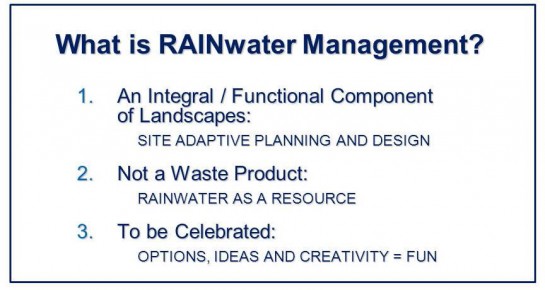Companion Website: Rainwater Management Community-of-Interest provides the complete story of the new business as usual
From Stormater to RAINwater
The Inter-Governmental Partnership responsible for the Water Balance Model powered by QUALHYMO collaborated with the Waterbucket Website Partnership in 2005 to develop the Rainwater Management Community-of-Interest as a companion website to the Convening for Action Community-of-Interest.
 “The goal in creating the companion Rainwater Management website was to inform British Columbia local governments and practitioners about case studies and the latest advances in the state-of-the-practice,” explains Ted van der Gulik, PartnershipChair.
“The goal in creating the companion Rainwater Management website was to inform British Columbia local governments and practitioners about case studies and the latest advances in the state-of-the-practice,” explains Ted van der Gulik, PartnershipChair.
“Stormwater suggests there is a problem, whereas rainwater is a resource. In British Columbia, the single function view of traditional ‘stormwater management’ is giving way to the integrated and comprehensive perspective that is captured by the term ‘RAINwater management’.”
The evolution from Stormwater Management to RAINwater Management is illustrated by the following comparison:
Why RAINwater Management
At a workshop organized by the Capital Regional District in November 2007, Paul de Greef, landscape planner, provided this thought-provoking perspective about drivers for innovation:
“ If we view rainwater management comprehensively, it starts with an understanding of site processes, systems and context. If we don’t first understand the systems that we are designing within, and the full breadth of constraints and opportunities present on a site, fitting rainwater management systems into the landscape is a bit like making a medical diagnosis and prescription without first taking a patient history, lab tests or in any way trying to understand the patient.”
If we view rainwater management comprehensively, it starts with an understanding of site processes, systems and context. If we don’t first understand the systems that we are designing within, and the full breadth of constraints and opportunities present on a site, fitting rainwater management systems into the landscape is a bit like making a medical diagnosis and prescription without first taking a patient history, lab tests or in any way trying to understand the patient.”
“An appreciation that every site is different and has different needs or resiliencies is an essential first step for achieving innovative rainwater management”, observed de Greef.
Historical Context
“The term RAINwater management resonates with non-engineers and the community at large. They intuitively get it,” added Kim Stephens, Executive Director for the Partnership for Water Sustainability in British Columbia; and principal author of Stormwater Planning: A Guidebook for British Columbia, published in 2002.
“When I graduated from university in 1973, runoff from land was called drainage. Then in the mid-1970s the term stormwater management appeared in the literature,” explained Stephens, “As far as I can determine, this terminology originated with the “pipe guys” who were primarily concerned with making the distinction between sanitary and storm flows in combined sewer systems.”
“Contemporary RAINwater management is about integration and an interdisciplinary approach that is landscape-based, and therefore goes well beyond the narrow engineering definition for conventional stormwater management”, concluded Stephens.
Integration with Community Design
RAINwater management integrates drainage infrastructure planning with relevant municipal planning processes – such as Official Community Plans, Neighbourhood Concept Plans, recreation and parks plans, and even strategic transportation plans – to address the impacts of rainwater on community values. In the British Columbia context, the vision is to create a lasting legacy through a design with nature approach to integration of rainwater management with community design.
“The desired outcome is to improve both the natural and built environments in an urban setting”, observes Ted van der Gulik. “This means determining how rainwater management objectives can be integrated with land development processes and tools to mitigate the cumulative impacts of landscape alteration, and produce cumulative watershed landscape benefits.”




